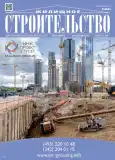Monitoring of Architectural Monuments
- Authors: Shashkin V.A.1
-
Affiliations:
- Institute “Georeconstruction”
- Issue: No 9 (2024)
- Pages: 53-66
- Section: Articles
- URL: https://modernonco.orscience.ru/0044-4472/article/view/642657
- DOI: https://doi.org/10.31659/0044-4472-2024-9-53-66
- ID: 642657
Cite item
Abstract
The article presents the main provisions that it is advisable to follow when organizing and conducting monitoring during the operation of cultural heritage sites. It is noted that the existing regulatory documents do not take into account the specifics of monitoring during operation, but are mainly aimed at protecting the monument from neighboring construction.Criteria are proposed to control the technical condition of historical buildings. Among them is the rate of development of long-term precipitation, which is considered as an indicator of the intensity of natural and man-made impacts on the building.Among them is the rate of development of long-term precipitation, which is considered as an indicator of the intensity of natural and man-made impacts on the building. It is noted that for stone structures, critical masonry stretching deformations serve as an effective criterion for the preservation of historical buildings, since in calculating the interaction of structures and foundations they are the primary criterion for calculating the second group of limiting states. In relation to it, the criterion of absolute precipitation and relative difference of precipitation is secondary. It is shown that over time, for buildings built on weak water-saturated clay soils, an increase in the unevenness of precipitation occurs. Special attention is paid to taking into account the accumulated uneven precipitation of buildings of historical development. The article presents the most characteristic types of deformations of buildings, among which in St. Petersburg the bend is most common, which is due to the regularity of building and rebuilding sections of urban neighborhoods.Monitoring is also considered as a reliable means of diagnosing the technical condition of the monument. The monitoring function is considered as a means of controlling the limitations of the monument’s operability, which continues to be operated in conditions of limited operational technical condition.
Full Text
About the authors
V. A. Shashkin
Institute “Georeconstruction”
Author for correspondence.
Email: yashashkin@pi-georeconstruction.ru
Candidate of Sciences (Engineering)
Russian Federation, 4, Izmaylovskiy pr. Saint-Petersburg, 190005References
- Shashkin A.G., Shashkin K.G., Bogov S.G., Shashkin V.A., Shashkin M.A. Monitoring zdanii i sooruzhenii pri stroitel’stve i ekspluatatsii [Monitoring of buildings and structures during construction and operation]. Saint Petersburg: Georeconstruktsiya. 2021. 640 p.
- Shashkin K.G. Theoretical foundations of interactive monitoring of complex buildings and underground structures. Geotechnika. 2018. No. 3, pp. 26–37. (In Russian).
- Orlovich R.B., Chakalidi V.H. Methods of strengthening cylindrical stone vaults. Theory of engineering structures. Stroitel’nye konstruktsii. 2017. No. 1 (69), pp. 50–55. (In Russian).
- Tiunov O.V., Shashkin A.G. Kizhi. Preobrazhenie [Kizhi. Transfiguration]. Saint Petersburg: Georeconstruktsiya. 2020. 336 p.
- Shashkin V.A. Construction of foundations of buildings of ordinary buildings of the XVIII – early XIX centuries. (on the example of St. Petersburg). Geotechnika. 2022. Vol. 14. No. 3, pp. 6–20. (In Russian).
- Shashkin V.A. The device of foundations and foundations in the XIX – early XX centuries. Geotechnika. 2022. Vol. 14. No. 4, pp. 6–22. (In Russian).
- Ulitsky V.M., Shashkin A.G. The concept of geotechnical support for construction and reconstruction for the new edition of St. Petersburg geotechnical norms. Rekonstruktsiya gorodov i geotekhnicheskoe stroitel’stvo. 2003. No. 5, pp. 29–43. (In Russian).
- Golly A.V., Shashkin A.G. Monitoring of the stress-strain state of weak clay soils (field studies of the deformation process of the foundation of structures protecting St. Petersburg from floods). Rekonstruktsiya gorodov i geotekhnicheskoe stroitel’stvo. 2000. No. 1, pp. 115–126. (In Russian).
- Vasenin V.A., Shashkin A.G. Precipitation of buildings on weak clay soils (on the example of the development of St. Petersburg). Geotechnika. 2018. No. 4, pp. 32–44. (In Russian).
- Vasenin V.A. Assessment of the development of sediments of the historical buildings of St. Petersburg based on the results of observations since the end of the 19th century. Osnovaniya, fundamenty i mekhanika gruntov. 2013. No. 4, pp. 2–7. (In Russian).
- Shashkin A.G., Vasenin V.A. Vekovye osadki zdanii Sankt-Peterburga [Age-old precipitation of buildings in St. Petersburg]. Saint Petersburg: Georeconstruktciya. 2022. 440 p.
- Dashko R.E., Alexandrova O.Yu., Kotyukov P.V., Shidlovskaya A.V. Features of engineering and geological conditions of St. Petersburg. Razvitie gorodov i geotekhnicheskoe stroitel’stvo. 2011. No. 13, pp. 25–71. (In Russian).
- Shashkin V. G., Glybin L. A. Diagnostics of the technical condition of the Exchange building on the spit of Vasilyevsky Island. Promyshlennoe i grazhdanskoe stroitel’stvo. 2017. No. 12, pp. 68–76. (In Russian).
- Sementsov S.V. Formation of the principles of preservation of the architectural and urban heritage of St. Petersburg based on the patterns of three-century urban development. Vestnik Sankt-Peterburgskogo universiteta. 2013. Ser. 15. Iss. 2, pp. 190–211. (In Russian).
- Sementsov S.V. Urban planning component of the residential function of St. Petersburg and the St. Petersburg agglomeration. 1703–2006. Vestnik of St. Petersburg University. 2007. Iss. 3, pp. 63–70. (In Russian).
- Shashkin A.G., Shashkin V.A. Reglamentation of urban planning activities in St. Petersburg in the 18th–19th centuries and its technical consequences. Zhilishchnoe Stroitel’stvo [Housing Construction]. 2023. No. 9, pp. 86–101. (In Russian). https:// doi.org/10.31659/0044-4472-2023-9-86-101
- Shashkin V.A. Accumulated deformations of the historical development of St. Petersburg. Zhilishchnoe Stroitel’stvo [Housing Construction]. 2023. No. 12, pp. 32–45. (In Russian). https://doi.org/10.31659/0044-4472-2023-12-32-45
- Voynarovsky A.E., Leontieva A.B. Photogrammetric methods for monitoring deformations of buildings and structures, a modern approach. Materials of the International Scientific and Practical Conference “Geodesy, cartography, geoinformatics and cadastres. From idea to implementation”, November 11–13, 2015. Saint Petersburg, pp. 69–70. (In Russian).
Supplementary files
















